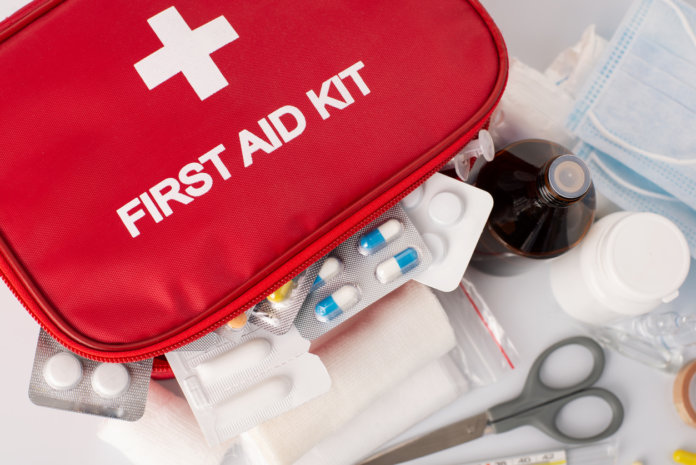One of the most important things you can have available in your home is a well-stocked first-aid kit. First-aid kits are essential to treat minor cuts, burns, sprains and strains. In more extreme cases, they may save lives. Minor and major injuries can happen at any time. So it’s important to be able to treat them with speed and efficiency. It’s easy to buy ready-made first-aid kits, but you can also assemble your own with ease and without spending a fortune. Another perk when you make your own first-aid kit is the ability to tailor it to the specific needs of you and your family. Still, certain supplies are essential to every first-aid kit. You can customize to infinity when you make your own first-aid kid, but be sure to include at least the following items.
Adhesive medical tape
A variety of bandages is the glue that literally holds everything together when you make your own first-aid kit. Adhesive tape holds bandages and other dressings in place to keep wounds clean and avoid infection. Use something durable but breathable. A waterproof cloth adhesive tape is great because it is flexible, painless and easy to remove and can withstand moisture.
Various adhesive bandages
Bandages in assorted sizes are key. These include fingertip and butterfly bandages. You can use butterfly bandages in place of stitches to close small, shallow cuts. Here again, waterproof is a good choice. With this variety you will be able to cover most cuts and scrapes.
Self-adhering wrap bandages
Add some elastic wrap bandages to your kit, including triangular bandages. Self-adhering elastic wrap bandages are a great choice as they stick to themselves, are easy to tear and you can use them to treat a variety of injuries. A triangular bandage is a large triangle of cloth that you can use as an arm sling, as binding for a splint, as a tourniquet or to hold cold packs in place.
Non-stick gauze pads
Nonstick sterile bandages and gauze cover larger open wounds. The non-stick bandages use absorbent material so they and the wound stay clean and dry. You will need the gauze to secure the non-stick pad to the wound.
Instant cold packs
Instant cold packs are on-the-go cold compresses that ease pain from cuts, burns, bruises and minor sprains. An instant cold pack is ideal for portable first-aid kits because it does not need to be pre-chilled.
Gloves
Nitrile or vinyl gloves will protect you from blood-borne pathogens, other fluids and germs if you’re administering first aid to someone else. Nitrile or vinyl are better than latex because many people are allergic to latex. Keep at least two pairs in your kit.
Safety pins
Safety pins are for securing wraps and bandages. You can even use clothing as make-shift bandaging in a pinch, in which case safety pins could be literal life-savers. You should have assorted safety pins in small, medium and large sizes. A well-stocked kit has will have 10 to 15 pins.
Thermometer
A thermometer is an important item to include because your temperature is one of your vital signs. An oral digital thermometer or disposable single-use thermometers are both great options that are safe and easy to use.
Antihistamines
You should include antihistamine medication (diphenhydramine) in your kit because it serves as critical treatment for insect bites, hives and allergic reactions that can be dangerous and even deadly. You probably know diphenhydramine better by the brand name Benadryl.
First-aid scissors
Scissors and tweezers are something you will not want to find your kit without. First-aid scissors are for cutting gauze and bandages to fit wounds and helping remove dressings in a way that will reduce the risk of infection. Tweezers are for removing splinters, glass, dirt and other debris from wounds before cleaning and dressing them.
Antibiotic ointment
Antibiotic ointment is effective for treating small wounds and prevent infection in minor burns, cuts and scrapes. A triple antibiotic ointment is a good way to go because it provides three-in-one strength.
Antiseptic
An antiseptic solution is also a necessary component for cleaning injuries like cuts and burns and to prevent the risk of infection. You can get either an antiseptic spray or antiseptic wipes for safety and ease of use.
Pain relievers
Pain relievers like ibuprofen, aspirin and acetaminophen are important because they not only relieve pain, but they are anti-inflammatory and can reduce fever. Popular brands of ibuprofen, aspirin and acetaminophen with which you’re probably familiar are Advil, Bayer and Tylenol.
Breathing barrier/CPR mask
A breathing barrier will be important to have in the instance you find yourself having to provide CPR. A one-way valve breathing barrier helps prevent disease transmission by eliminating direct contact with the patient’s mouth.
First-aid manual
A first-aid manual will also be very important as all the above supplies will do you little to no good if you don’t know how to use them the right way. A quick and easy guide will help you administer basic first aid even if you have no formal training.
Final thoughts
Aside from the above, you can include any personal medications or EpiPens if you have a specific and severe allergy. You should also include emergency information like medical histories and phone numbers for your doctors and local emergency services.
Make regular checks of your kit to ensure that it has fresh supplies. Replace any expired, out-of-date items.




